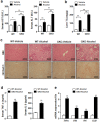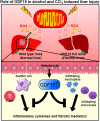GDF15 deficiency exacerbates chronic alcohol- and carbon tetrachloride-induced liver injury
- PMID: 29222479
- PMCID: PMC5722931
- DOI: 10.1038/s41598-017-17574-w
GDF15 deficiency exacerbates chronic alcohol- and carbon tetrachloride-induced liver injury
Abstract
Growth differentiation factor 15 (GDF15) has recently been shown to have an important role in the regulation of mitochondrial function and in the pathogenesis of complex human diseases. Nevertheless, the role of GDF15 in alcohol-induced or fibrotic liver diseases has yet to be determined. In this study, we demonstrate that alcohol- or carbon tetrachloride (CCl4)-mediated hepatic GDF15 production ameliorates liver inflammation and fibrosis. Alcohol directly enhanced GDF15 expression in primary hepatocytes, which led to increased oxygen consumption. Moreover, GDF15 reduced the expression of pro-inflammatory cytokines in liver-resident macrophages, leading to an improvement in inflammation and fibrosis in the liver. GDF15 knockout (KO) mice had more TNF-α-producing T cells and more activated CD4+ and CD8+ T cells in the liver than wild-type mice. Liver-infiltrating monocytes and neutrophils were also increased in the GDF15 KO mice during liver fibrogenesis. These changes in hepatic immune cells were associated with increased tissue inflammation and fibrosis. Finally, recombinant GDF15 decreased the expression of pro-inflammatory cytokines and fibrotic mediators and prevented the activation of T cells in the livers of mice with CCl4-induced liver fibrosis. These results suggest that GDF15 could be a potential therapeutic target for the treatment of alcohol-induced and fibrotic liver diseases.
Conflict of interest statement
The authors declare that they have no competing interests.
Figures







Similar articles
-
GDF15 Ameliorates Liver Fibrosis by Metabolic Reprogramming of Macrophages to Acquire Anti-Inflammatory Properties.Cell Mol Gastroenterol Hepatol. 2023;16(5):711-734. doi: 10.1016/j.jcmgh.2023.07.009. Epub 2023 Jul 25. Cell Mol Gastroenterol Hepatol. 2023. PMID: 37499753 Free PMC article.
-
Hepatic estrogen-related receptor gamma is a key regulator of GDF15 production in acute and chronic liver injury.Mol Cell Endocrinol. 2025 Sep 1;606:112572. doi: 10.1016/j.mce.2025.112572. Epub 2025 May 14. Mol Cell Endocrinol. 2025. PMID: 40379080
-
Caveolin-1 Deficiency Protects Mice Against Carbon Tetrachloride-Induced Acute Liver Injury Through Regulating Polarization of Hepatic Macrophages.Front Immunol. 2021 Aug 9;12:713808. doi: 10.3389/fimmu.2021.713808. eCollection 2021. Front Immunol. 2021. PMID: 34434195 Free PMC article.
-
Hepatotoxicity and mechanism of action of haloalkanes: carbon tetrachloride as a toxicological model.Crit Rev Toxicol. 2003;33(2):105-36. doi: 10.1080/713611034. Crit Rev Toxicol. 2003. PMID: 12708612 Review.
-
GDF15 as a key disease target and biomarker: linking chronic lung diseases and ageing.Mol Cell Biochem. 2024 Mar;479(3):453-466. doi: 10.1007/s11010-023-04743-x. Epub 2023 Apr 24. Mol Cell Biochem. 2024. PMID: 37093513 Free PMC article. Review.
Cited by
-
GDF15: an emerging modulator of immunity and a strategy in COVID-19 in association with iron metabolism.Trends Endocrinol Metab. 2021 Nov;32(11):875-889. doi: 10.1016/j.tem.2021.08.011. Epub 2021 Sep 8. Trends Endocrinol Metab. 2021. PMID: 34593305 Free PMC article. Review.
-
GDF15 and Cardiac Cells: Current Concepts and New Insights.Int J Mol Sci. 2021 Aug 18;22(16):8889. doi: 10.3390/ijms22168889. Int J Mol Sci. 2021. PMID: 34445593 Free PMC article. Review.
-
Regulation of Systemic Glucose Homeostasis by T Helper Type 2 Cytokines.Diabetes Metab J. 2019 Oct;43(5):549-559. doi: 10.4093/dmj.2019.0157. Diabetes Metab J. 2019. PMID: 31694077 Free PMC article. Review.
-
GDF15 Suppresses Lymphoproliferation and Humoral Autoimmunity in a Murine Model of Systemic Lupus Erythematosus.J Innate Immun. 2022;14(6):673-689. doi: 10.1159/000523991. Epub 2022 Apr 20. J Innate Immun. 2022. PMID: 35443244 Free PMC article.
-
Beneficial Effects of Low-Grade Mitochondrial Stress on Metabolic Diseases and Aging.Yonsei Med J. 2024 Feb;65(2):55-69. doi: 10.3349/ymj.2023.0131. Yonsei Med J. 2024. PMID: 38288646 Free PMC article. Review.
References
-
- Tsuchida, T. & Friedman, S. L. Mechanisms of hepatic stellate cell activation. Nature reviews. Gastroenterology & hepatology, doi:10.1038/nrgastro.2017.38 (2017). - PubMed
Publication types
MeSH terms
Substances
LinkOut - more resources
Full Text Sources
Other Literature Sources
Medical
Molecular Biology Databases
Research Materials

